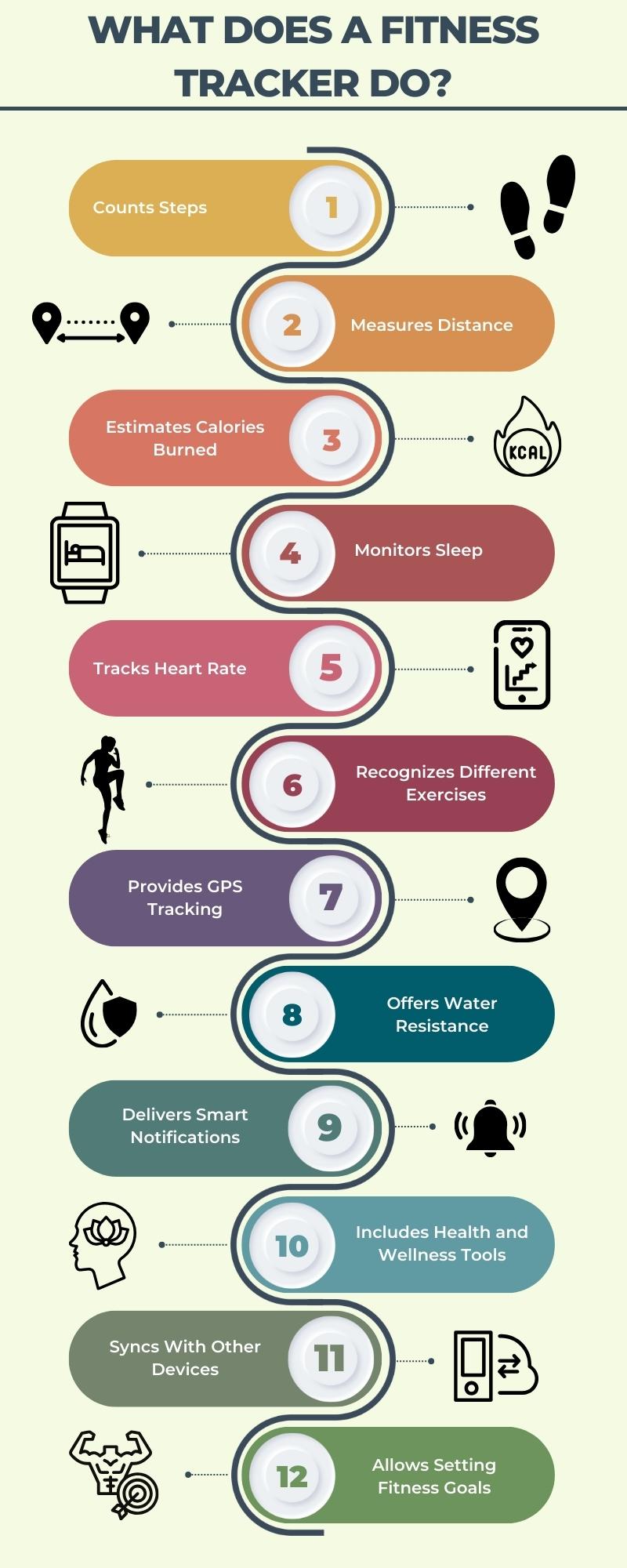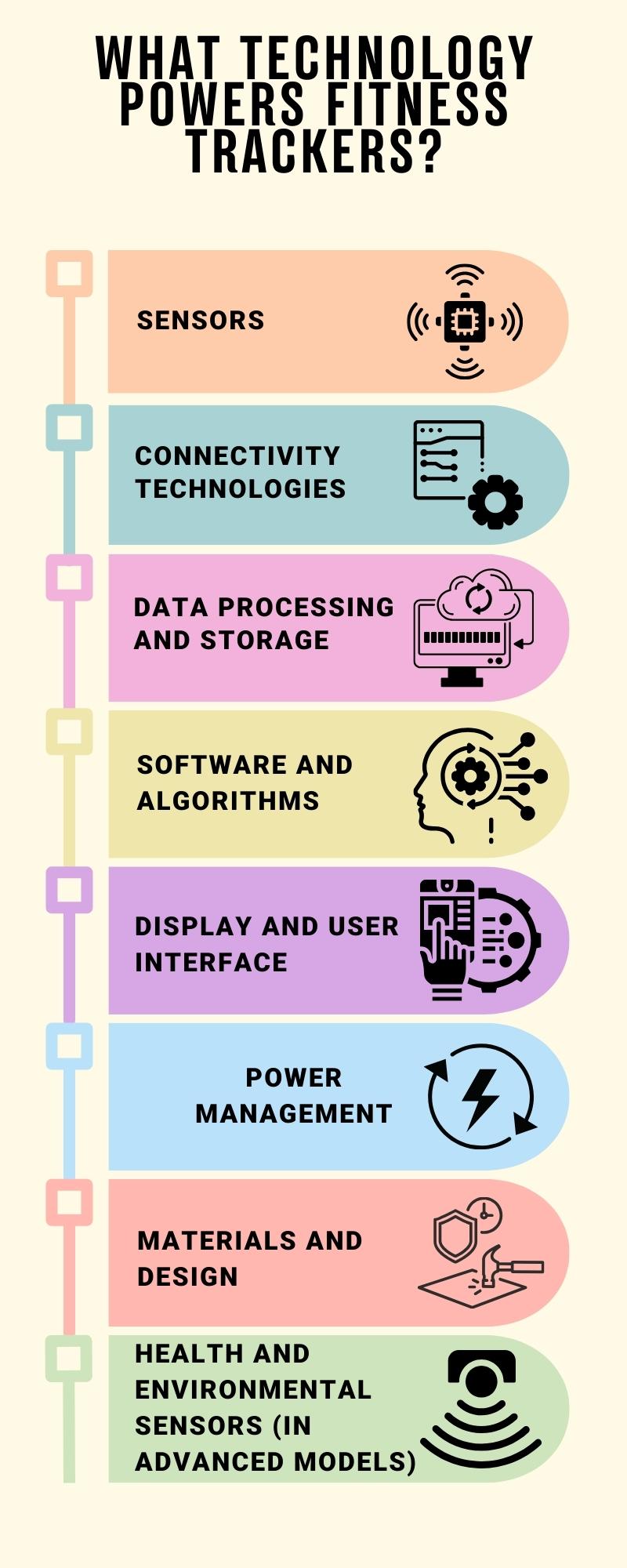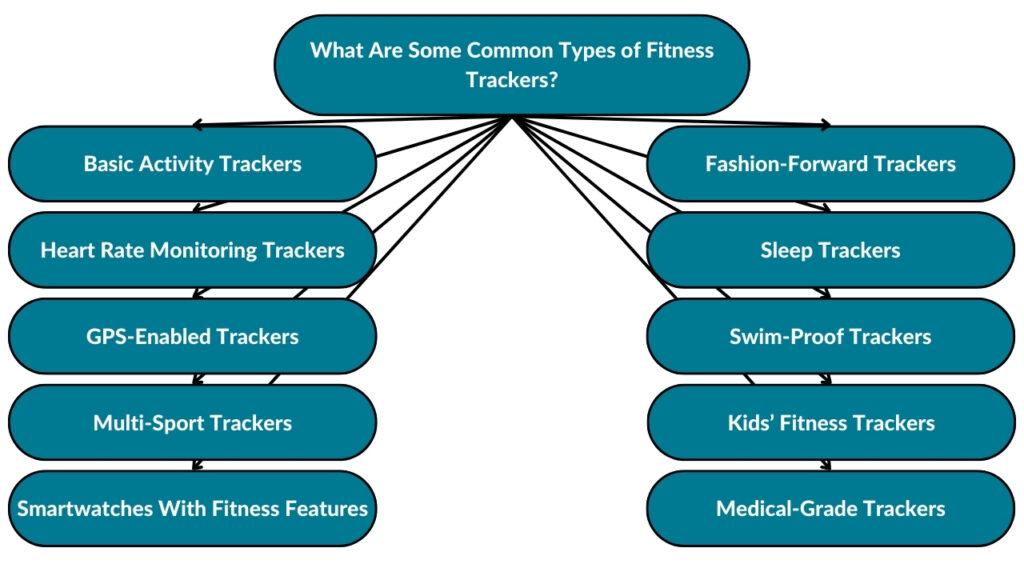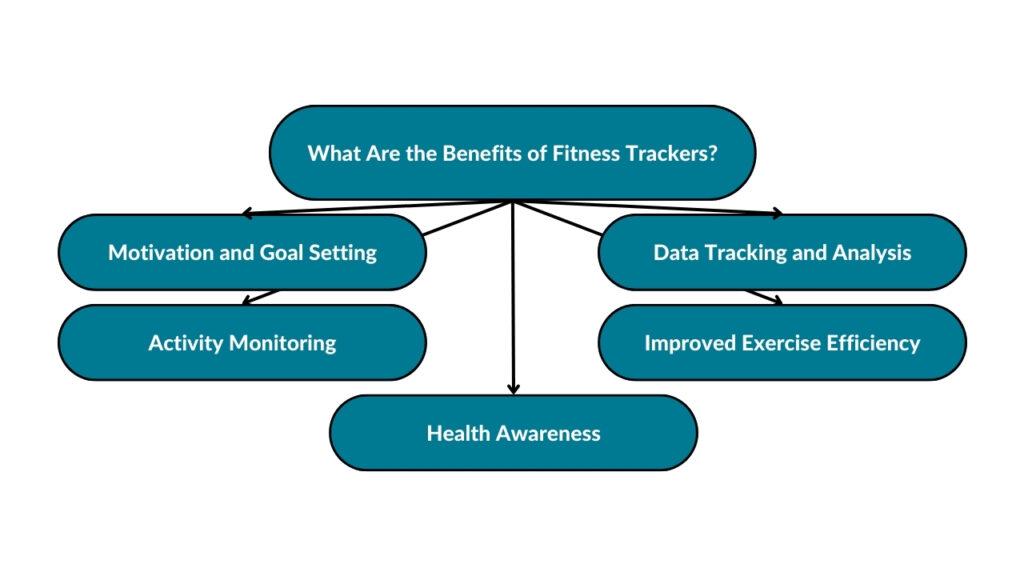So what is a fitness tracker, and what is it used for? Fitness trackers represent invaluable pieces of technology that are used to facilitate self-monitoring of information related to our health.
Table of Contents
ToggleOne of the studies from PubMed Central titled “Health Habits and Wearable Activity Tracker Devices: Analytical Cross-Sectional Study” concluded that for every 1-point increase in BMI, the odds of using a tracker device increased by 5.2% [1].
This points out that individuals with higher BMI were more likely to turn to technology such as fitness trackers.
And who is to blame them?
The same study also found that the use of a fitness tracker was correlated positively with lower cardiovascular disease mortality risk related to sitting time.
In essence, using fitness trackers and making them a part of your daily habits, rituals, and workouts is shown to be positive for your health and fitness progress.
In the sections below, I will aim to demystify everything about fitness trackers further, starting from their definition, how they work, what they do, the technology behind them, benefits, types, and more.
Start Building Your Dream Body Today
Ready to elevate your fitness game without falling into the trap of dull, repetitive routines that just don’t deliver? Imagine sculpting your ideal physique and boosting your health, all while still enjoying life’s pleasures, like those irresistible weekend getaways and your aunt’s legendary cheesecake. With our online fitness and nutrition coaching service, you don’t have to compromise. Dive into a personalized fitness journey that blends perfectly with your lifestyle, not against it. Book your completely free discovery consultation today, and take the first step towards a transformation that doesn’t require giving up the joys of life.

“I was skeptical about online fitness coaching, but Functional Body Savage completely changed my perspective. Vanja and Radomir’s personalized approach and attention to detail have helped me achieve goals I never thought possible. I’m stronger, more confident, and grateful for their guidance.”
Emily Thompson, San Francisco, CA
Learn More About Our Online Coaching ServiceQuick Summary
- Fitness trackers are advanced devices designed to monitor and record a variety of physical activities and health data, aiding in self-monitoring and promoting healthier lifestyles.
- These devices offer functionalities ranging from basic activity tracking to advanced health monitoring, including step counting, heart rate monitoring, sleep tracking, and GPS-enabled exercise mapping, and some advanced models even feature blood oxygen monitoring and respiratory rate tracking, enhancing their capability to monitor vital signs.
- A study from PubMed Central revealed that for every 1-point increase in BMI, the likelihood of using a fitness tracker increased by 5.2%, likely indicating their growing popularity among individuals seeking to improve their health.
- Drawing from a wealth of practical applications, it’s evident that the integration of fitness trackers into daily routines significantly contributes to enhanced health awareness and motivates individuals to achieve their fitness goals.
What Is a Fitness Tracker?
A fitness tracker is a wearable device that monitors and records various physical activities and health data. It typically tracks steps taken, distance traveled, calories burned, and heart rate, and sometimes also performs sleep tracking to assess sleep quality.
Most fitness trackers sync with smartphones or computers to store and analyze data, helping users monitor their fitness progress and health goals.
Who Invented the First Fitness Tracker?
Dr. Yoshiro Hatano, a Japanese professor at Kyushu University of Health and Welfare, invented the first fitness tracker.

Where Does the Universal Rule of 10 000 Steps Daily Come From?
The universal rule of 10,000 steps daily comes from the invention of the “manpo-kei” in Japan by Dr. Yoshiro Hatano in the 1960s. Dr. Hatano, a Japanese researcher, created this pedometer to promote fitness and combat obesity.
He proposed the 10,000 steps target based on his research, which suggested that this number of steps was a balance between the caloric intake and expenditure necessary to maintain a healthier lifestyle.

The term “manpo-kei” translates to “10,000 steps meter,” and this concept gained popularity, eventually becoming a widely accepted guideline for daily physical activity around the world. Today, I believe almost every fitness community and fitness professional has adopted the philosophy of 10,000 steps for better health and longevity.
Another study on the National Center for Biotechnology Information website that evaluated the effects of 10,000 steps a day on physical and mental health in overweight participants found significantly lower anxiety, depression, anger, fatigue, confusion, and total mood distress scores [2].
Check out our comprehensive buyer’s guide in case you are looking for a specialized fitness tracker for pushing a stroller.
How Do Fitness Trackers Work?
Fitness trackers work by using a combination of sensors and algorithms to monitor and record your physical activity and other health-related metrics. Typically, a basic fitness tracker includes accelerometers and gyroscopes to track your movement and steps, estimating the distance traveled and calories burned.
Some smart tech fitness trackers also have heart rate monitors, usually through optical sensors, to measure the pulse. I have also seen certain advanced models come with GPS for more accurate distance tracking and altimeters to measure elevation changes.
Based on my research, algorithms then process the data collected to provide insights into the user’s physical activity levels, sleep patterns, and overall health. You can access this information often via an app or website, allowing you to track your progress over time with a smart fitness tracker.
Now, you might ask how accurate these wearable devices are.
One study from PubMed titled “Accuracy and Acceptability of Wrist-Wearable Activity-Tracking Devices” concluded that the Fitbit Charge and Fitbit Charge HR were consistently shown to have good accuracy for step counts and the Apple Watch for measuring heart rate [3].
However, the study also showed that none of the tested devices proved to be accurate in measuring energy expenditure.
What Does a Fitness Tracker Do?
What a fitness tracker does is count steps, measure distance, estimate calories burned, monitor sleep, track heart rate, recognize different exercises, provide GPS tracking, deliver smart notifications, allow setting fitness goals, and much more.

Now, let’s tackle each of these below.
Counts Steps
Fitness trackers use accelerometers to detect motion and count steps. These devices are sensitive enough to differentiate between actual steps and other movements, ensuring accuracy in step counting.
They help users track their daily activity levels and encourage movement, aiming for a healthy step count each day. Many trackers also allow users to set daily step goals, motivating them to achieve more active lifestyles.
A study named “Stepping Up Activity Poststroke: Ankle-Positioned Accelerometer Can Accurately Record Steps During Slow Walking,” accessible on the Europe PubMed Central website, demonstrated that accelerometers, commonly included in ankle fitness trackers, exhibited an error margin of 10% or less when placed at the ankle across walking speeds ranging from 0.4 to 0.9 meters per second [4].
Also, in my experience, if you walk extremely slowly or have an unusual walking style, they will likely underestimate your steps. On the contrary, if you tend to move your hands a lot, they will likely overestimate your steps.
Measures Distance
By counting steps and incorporating the user’s stride length, fitness trackers estimate the total distance traveled. This feature is particularly useful for walkers, runners, and hikers to monitor their daily and cumulative distances. It helps in setting and achieving distance-based goals and can be instrumental in training for events like marathons or long-distance treks.
Estimates Calories Burned
Fitness trackers estimate calories burned by analyzing the intensity and duration of physical activity, along with personal data like weight, height, age, and gender. This information is valuable for those monitoring their calorie intake for weight management.
It also helps in understanding the energy expenditure of different activities, aiding in creating balanced workout routines.
Monitors Sleep
Fitness trackers monitor sleep, including features like nap detection, by detecting periods of inactivity and a consistent, low heart rate, typical of sleeping states. They also assess breathing rate during sleep, contributing to a comprehensive sleep quality analysis. They track sleep duration and quality, including light, deep, and REM sleep phases.
Understanding sleep patterns can lead to improved sleep hygiene and overall health. Some trackers also offer features like smart alarms to wake users up at the optimal sleep phase.
Tracks Heart Rate
Optical heart rate monitors in fitness trackers measure the pulse by tracking blood flow using LED lights.
They provide continuous or activity-specific heart rate data, which is essential for monitoring cardiovascular health and understanding workout intensity. This feature is also used to estimate calorie burn more accurately and can alert users to potential health issues.
In my experience, heart rate tracking is especially useful for seniors looking to monitor their health and improve their quality of life.
Most of these seniors don’t want to use their smartphones and additional technology together with fitness trackers when partaking in daily physical activities. However, the issue is that the best fitness tracker for seniors without smartphone isn’t easy to find. Most fitness trackers are either too complicated to understand, or seniors simply don’t want to use their smartphones when participating in daily fitness activities.
Fitness trackers are extremely precise in measuring your heart rate when you are resting. However, based on my tests, they are a little less accurate when it comes to measuring your heart rate when exercising since they tend to underestimate it.
Recognizes Different Exercises
Advanced fitness trackers, including unlikely fitness trackers like the Google Pixel Watch and fitness watch models, automatically recognize various exercises like walking, running, swimming, or cycling. These devices track activity with data-driven progress, providing insights into a range of physical activities.
This automatic detection ensures that all physical activities contribute to the user’s fitness data, providing a comprehensive view of their exercise regimen. Users can track specific workouts, monitor progress in different activities, and adjust their routines based on this data.
Provides GPS Tracking
Many fitness trackers with GPS functionality offer precise tracking of geographical locations during outdoor activities.
This feature is invaluable for mapping routes in activities like running, cycling, and hiking. It provides detailed data on pace, distance, elevation gain, and route history, which is particularly useful for outdoor enthusiasts and athletes.
Offers Water Resistance
Water-resistant fitness trackers can withstand exposure to water, making them suitable for swimming, showering, and other water-based activities. The degree of water resistance varies among devices, with some able to withstand submersion in water for extended periods.
This feature extends the versatility of fitness trackers, allowing users to track their activity in various environments.
Delivers Smart Notifications
When synced with smartphones, fitness trackers display notifications for calls, texts, emails, and app alerts.
This feature keeps users connected without needing to access their phones constantly. It’s particularly useful during workouts, meetings, or other situations where checking a phone isn’t feasible.
Includes Health and Wellness Tools
Fitness trackers often include additional tools for monitoring and improving health and wellness. These can include stress tracking, menstrual cycle tracking, guided breathing exercises, and sedentary reminders. These features provide a holistic approach to health, focusing not just on physical fitness but overall well-being.
Syncs With Other Devices
Fitness trackers can wirelessly sync data with smartphones, computers, and sometimes other health devices, creating a comprehensive health data ecosystem.
This synchronization allows for easier tracking and analysis of health data over time and facilitates sharing information with healthcare providers for better health management.
Allows Setting Fitness Goals
Users can set specific fitness goals on their tracker, such as a daily step count or weekly exercise minutes. The best fitness trackers track progress towards these goals, providing real-time feedback and motivation.
This feature helps users stay committed to their fitness objectives and celebrate achievements, fostering a sense of accomplishment. One of the studies from PubMed Central found that goal-setting methods are sufficient in helping people initiate and sustain healthy behavior over time [5].
What Technology Powers Fitness Trackers?
The technology that powers fitness trackers includes sensors, connectivity technologies, data processing and storage, software and algorithms, display and user interface, power management, materials and design, and health and environmental sensors in advanced fitness trackers.

Let’s cover each of these unique technologies below.
Sensors
According to my research, sensors are the core components of fitness trackers, responsible for data collection. They include accelerometers and gyroscopes that detect and measure motion, translating physical activities into digital data. Heart rate monitors, often using optical sensors, track your pulse rates by detecting blood flow changes.
Some of these trackers also incorporate altimeters to measure elevation changes, which is useful for activities like hiking or stair climbing. These sensors work in tandem to provide a comprehensive overview of the user’s physical activity and health metrics.
Connectivity Technologies
Fitness trackers use various connectivity technologies to sync data with other devices. Bluetooth is the most common, allowing for wireless communication with smartphones, tablets, and computers.
Wi-Fi connectivity in some models enables data syncing without a smartphone nearby, directly uploading data to cloud storage. NFC (Near Field Communication) is used in certain trackers for quick pairing with devices or contactless payments.
Data Processing and Storage
Data processing and storage are vital for turning raw sensor data into meaningful insights. Fitness trackers process data using built-in microprocessors, analyzing information like step count, distance, and heart rate.
They store data temporarily on the device and usually sync it to external storage like a smartphone app or cloud service. Based on my experience, this allows for long-term data tracking and analysis, helping you monitor trends and progress over time.
Software and Algorithms
Software and algorithms in fitness trackers interpret sensor data and provide user-friendly information. Algorithms calculate steps, distance, calories burned, sleep quality, and more. The software also includes user interfaces for setting goals, viewing progress, and receiving health insights.
I found through practical knowledge that regular software updates often bring new features and improvements in data accuracy and battery life.
Display and User Interface
The display and user interface are crucial for user interaction with the fitness tracker. Displays range from simple LED lights to advanced OLED touchscreens, showing time, activity data, notifications, and more.
The user interface design is crucial for ease of use, allowing users to navigate through various functions smoothly. I also found that some trackers offer customizable displays, letting users choose what information to see at a glance.
Power Management
Power management is key to ensuring fitness trackers last through days of use without frequent charging. This involves optimizing battery usage, with most trackers using rechargeable lithium-ion batteries.
Power-efficient components and software help extend battery life. Some advanced models I found on the market recently feature solar charging or energy-saving modes to enhance battery longevity further.
Materials and Design
The materials and design of fitness trackers focus on durability and comfort. They often use lightweight, hypoallergenic materials like silicone or aluminum for the bands and casing. The design is typically sleek and discreet, suitable for continuous wear. Water-resistant designs are common, allowing for use during various activities.
The aesthetic appeal is also considered, with many models offering interchangeable bands and customizable appearances.
Health and Environmental Sensors (In Advanced Models)
I found that advanced fitness trackers include additional health and environmental sensors for more comprehensive health monitoring. These can include skin temperature sensors, SpO2 sensors to measure blood oxygen levels, and UV light sensors to monitor sun exposure.
Some models feature electrodermal activity sensors to track stress levels. These advanced sensors provide deeper insights into overall health and well-being beyond basic fitness metrics.
What Are Some Common Types of Fitness Trackers?
Some common types of fitness trackers are basic activity trackers, heart rate monitoring trackers, GPS-enabled trackers, multi-sport trackers, smartwatches with fitness features, fashion-forward trackers, sleep trackers, swim-proof trackers, kids’ fitness trackers, and medical-grade trackers.

Let’s find out more about each of these types of fitness trackers below.
Basic Activity Trackers
Basic activity trackers are designed for everyday users who want to monitor their daily activities like steps taken, distance traveled, and calories burned. In my experience, these devices are typically lightweight and user-friendly and focus on fundamental fitness metrics.
They often lack advanced features like continuous heart rate monitoring or GPS but are ideal for those who need a simple tool to stay motivated and maintain an active lifestyle. Their affordability makes them accessible to a wide range of users.
Heart Rate Monitoring Trackers
Heart rate monitoring trackers are equipped with sensors that measure the wearer’s pulse rate.
These devices provide insights into heart health, workout intensity, and calorie burn more accurately. I believe they are ideal for fitness enthusiasts and athletes who want to optimize their training based on heart rate zones. Many of these trackers also offer additional features like sleep monitoring and stress tracking.
GPS-Enabled Trackers
GPS-enabled trackers are designed for outdoor enthusiasts and athletes who need precise data on their location, distance covered, and pace.
These trackers use satellite signals to provide accurate tracking of outdoor activities like running, cycling, and hiking. I find them to be perfect for training, racing, or exploring new trails, offering detailed route mapping and performance metrics.
Multi-Sport Trackers
Multi-sport trackers are versatile devices designed for individuals who engage in various types of physical activities.
They can track different sports and workouts, from running and swimming to cycling and gym sessions, adapting to different exercise modes. These trackers often come with a range of sensors and features to provide comprehensive data for each sport. I believe that this makes them ideal for multi-sport athletes and fitness enthusiasts.
Smartwatches With Fitness Features
Smartwatches with fitness features combine the functionalities of a traditional smartwatch with fitness-tracking capabilities. They offer a range of applications, notifications, and connectivity features, along with tracking fitness metrics like steps, heart rate, and sometimes even GPS tracking.
These devices are suitable for those who want a single device for both connectivity and fitness tracking.
Fashion-Forward Trackers
Fashion-forward trackers blend style with functionality. They are designed for users who want a fitness tracker that complements their personal style and can be worn on all occasions.
These trackers often come in various designs, materials, and colors, offering the same fitness-tracking capabilities but with an added focus on aesthetics.
Sleep Trackers
Sleep trackers focus specifically on monitoring sleep patterns and quality. They track various stages of sleep, including light, deep, and REM cycles, providing insights into sleep duration and disturbances.
Based on my tests, these devices are ideal for individuals looking to improve their sleep quality and understand how their daily activities affect their sleep.
Swim-Proof Trackers
Swim-proof trackers are designed for swimmers and water sports enthusiasts. They are water-resistant and can withstand prolonged exposure to water, making them suitable for tracking swimming laps, duration, and sometimes even stroke type.
These trackers are also useful for anyone who wants a device they don’t need to remove before showering or during water-related activities.
Kids’ Fitness Trackers
Kids’ fitness trackers are designed to encourage physical activity and healthy habits among children. These are usually made for small wrists, even though not every fitness tracker for small wrists is specifically made for kids but also for grownups who happen to have smaller wrist circumferences.
In addition to that, they are typically durable, easy to use, and come in fun, colorful designs. These trackers often include features like activity rewards, goal setting, and games to make fitness tracking enjoyable for kids.
Medical-Grade Trackers
Medical-grade trackers are advanced devices designed for health monitoring with a higher degree of accuracy and reliability. They are often used for monitoring specific health conditions, rehabilitation, or elderly care.
These trackers may include features like fall detection and heart rate variability and can sometimes even monitor specific medical conditions, providing valuable data for healthcare providers.
What Are the Benefits of Fitness Trackers?
The benefits of fitness trackers include motivation and goal setting, activity monitoring, health awareness, improved exercise efficiency, and data tracking and analysis.

Motivation and Goal Setting
Fitness trackers, evolving from the mechanical pedometer to sophisticated wearable pedometer devices, are powerful tools for boosting motivation and assisting in goal setting. They provide real-time feedback on heart rate readings, encouraging users to stay active and achieve their fitness goals.
They also allow users to set specific, measurable goals such as daily step counts, workout frequency, or calorie burn targets.
By providing real-time feedback and progress tracking, these devices create a sense of achievement and encourage users to push their limits. The gamification of fitness activities, including earning badges and competing with friends, further enhances motivation.
Activity Monitoring
These devices continuously monitor various physical activities, providing a comprehensive view of the user’s daily movement. This includes tracking steps, distance traveled, floors climbed, and active minutes. For those trying to lead a more active lifestyle, this constant monitoring helps in identifying periods of inactivity.
It likely encourages more movement throughout the day, contributing to overall health and well-being.
Health Awareness
Fitness trackers increase health awareness by providing valuable insights into various health metrics. They monitor heart rate, sleep patterns, and sometimes even stress levels, offering a holistic view of one’s health.
This constant monitoring can lead to early detection of potential health issues, encouraging timely medical consultation. It also helps users understand the impact of lifestyle choices on their health.
Improved Exercise Efficiency
For fitness enthusiasts and athletes, these devices optimize your exercise routine by providing data-driven insights.
Trackers with heart rate monitors help maintain the correct intensity level for workouts, ensuring efficient calorie burn and cardiovascular training. For those specifically seeking to optimize their treadmill workouts, exploring the best fitness devices for a treadmill can provide tailored solutions to enhance your training efficiency and monitor your progress accurately.
GPS-enabled trackers aid runners and cyclists in tracking pace and distance, helping in performance improvement. They also help in balancing workout types for overall fitness development.
Data Tracking and Analysis
Fitness trackers collect a wealth of data over time, which can be analyzed to track progress and identify trends. This long-term data tracking is invaluable for setting realistic fitness goals and devising effective workout plans.
It also allows users to see the impact of lifestyle changes on their health metrics, encouraging a data-informed approach to health and fitness. The ability to share this data with health professionals can also lead to more personalized healthcare advice.
FAQs
What Is the Difference Between a Fitness Tracker and a Smartwatch?
The difference between a fitness tracker and a smartwatch lies in their primary functions and features. A fitness tracker is primarily focused on tracking physical activities and health metrics, while a smartwatch offers broader functionalities, including mobile notifications, apps, and often more advanced connectivity features, in addition to fitness tracking capabilities.
What Are the Examples of Fitness Tracker?
Examples of fitness trackers include devices like Fitbit Charge, Garmin Vivosmart, Apple Watch Series (with fitness features), and Xiaomi Mi Band, each offering various functionalities to monitor health and fitness activities.
Why Should You Use a Fitness Tracker?
You should use a fitness tracker because it helps monitor physical activities, set and achieve fitness goals, and gain insights into health metrics like heart rate, sleep quality, and calorie expenditure, which can motivate a healthier lifestyle.
What Are the Disadvantages of a Fitness Tracker?
The disadvantages of a fitness tracker include potential inaccuracies in data tracking, limited battery life, dependency on smartphone connectivity for full functionality, and privacy concerns related to the sharing and storage of personal health data.
How Accurate Are Fitness Trackers?
Fitness trackers are generally accurate in basic functions like step counting and heart rate monitoring, but they may have limitations in accurately measuring more complex metrics like calorie burn and sleep quality, varying across different brands and models.
How Long Do Fitness Trackers Last Battery-Wise?
Fitness trackers last battery-wise from a few days to several weeks on a single charge, depending on the model, usage patterns, and specific features like GPS and heart rate monitoring, which can consume more power. Some basic models with limited features may offer longer battery life compared to advanced models with extensive functionalities.
Are People Who Do Fitness Tracking Healthier?
People who do fitness tracking tend to be healthier as they are more aware of their physical activity levels and health metrics. This can motivate them to maintain an active lifestyle and make healthier choices.
Wrapping Up
Fitness trackers have emerged as a pivotal technology in modern health and fitness regimes. They offer a range of functionalities, from basic activity tracking to advanced health monitoring, catering to diverse needs and preferences. Studies like the one from PubMed Central highlight the positive correlation between fitness tracker usage and health improvements, particularly in individuals with higher BMI.
These devices not only motivate users through goal setting and activity monitoring but also enhance health awareness and exercise efficiency. Despite some drawbacks like potential data inaccuracies and privacy concerns, the benefits of using fitness trackers are evident.
They encourage a proactive approach to health, making fitness a more integrated and accessible part of daily life. As technology evolves, fitness trackers continue to become more sophisticated, offering deeper insights and fostering healthier lifestyles.
Start Building Your Dream Body Today
Ready to elevate your fitness game without falling into the trap of dull, repetitive routines that just don’t deliver? Imagine sculpting your ideal physique and boosting your health, all while still enjoying life’s pleasures, like those irresistible weekend getaways and your aunt’s legendary cheesecake. With our online fitness and nutrition coaching service, you don’t have to compromise. Dive into a personalized fitness journey that blends perfectly with your lifestyle, not against it. Book your completely free discovery consultation today, and take the first step towards a transformation that doesn’t require giving up the joys of life.

“I was skeptical about online fitness coaching, but Functional Body Savage completely changed my perspective. Vanja and Radomir’s personalized approach and attention to detail have helped me achieve goals I never thought possible. I’m stronger, more confident, and grateful for their guidance.”
Emily Thompson, San Francisco, CA
Learn More About Our Online Coaching ServiceReferences:
- Tricás-Vidal HJ, Lucha-López MO, Hidalgo-García C, Vidal-Peracho MC, Monti-Ballano S, Tricás-Moreno JM. Health Habits and Wearable Activity Tracker Devices: Analytical Cross-Sectional Study. Sensors (Basel). 2022;22(8):2960. Published 2022 Apr 12. doi:10.3390/s22082960
- Yuenyongchaiwat K. Effects of 10,000 steps a day on physical and mental health in overweight participants in a community setting: a preliminary study. Braz J Phys Ther. 2016;20(4):367-373. doi:10.1590/bjpt-rbf.2014.0160
- Germini F, Noronha N, Borg Debono V, et al. Accuracy and Acceptability of Wrist-Wearable Activity-Tracking Devices: Systematic Review of the Literature. J Med Internet Res. 2022;24(1):e30791. Published 2022 Jan 21. doi:10.2196/30791
- Klassen TD, Simpson LA, Lim SB, et al. “Stepping Up” Activity Poststroke: Ankle-Positioned Accelerometer Can Accurately Record Steps During Slow Walking. Phys Ther. 2016;96(3):355-360. doi:10.2522/ptj.20140611.
- Paxton RJ, Taylor WC, Hudnall GE, Christie J. Goal Setting to Promote a Health Lifestyle. Int Proc Chem Biol Environ Eng. 2012;39:101-105.




